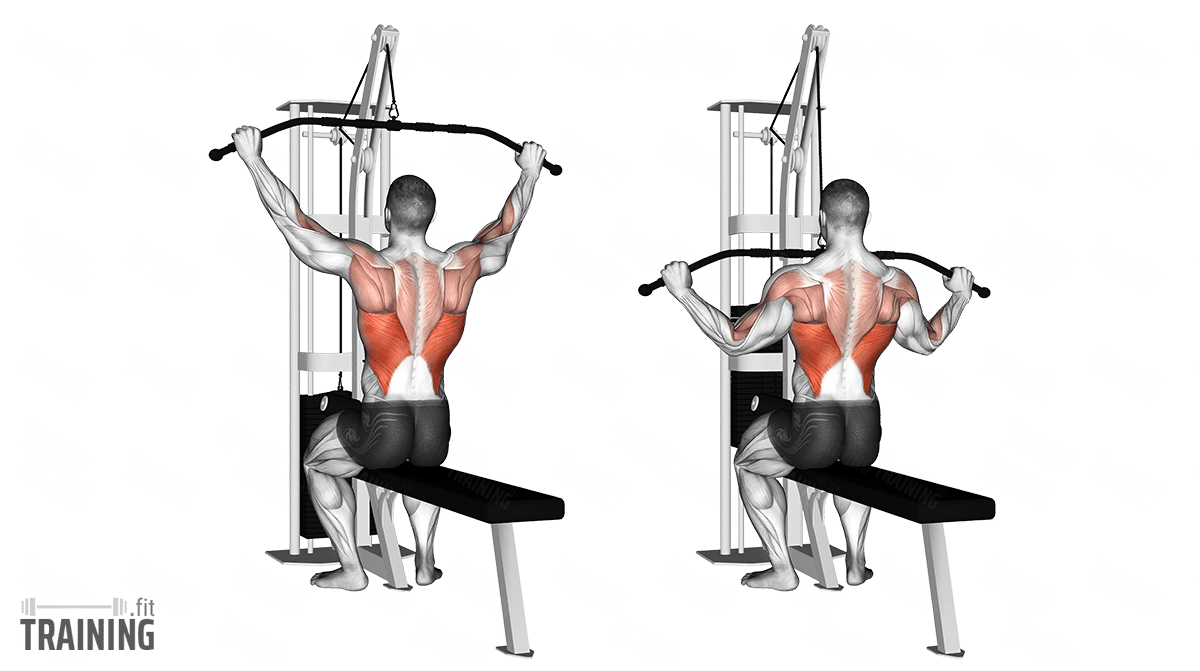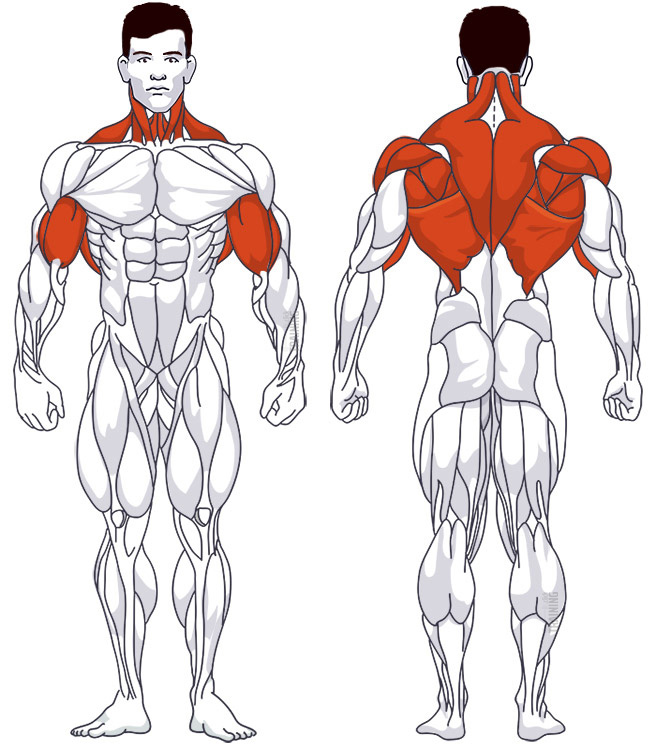Cable Lat Pulldown
Compound exercise, Cable pullThis article is verified by 2 studies/publications.
Overview

Main muscles
- Biceps: Arm flexor
(Musculus biceps brachii) - Upper arm: Coracobrachialis muscle
(Musculus coracobrachialis) - Neck: Trapezius muscle
(Musculus trapezius) - Back: Large round muscle
(Musculus teres major) - Back: Large back muscle
(Musculus latissimus dorsi) - Back: Larger rhomboid muscle
(Musculus rhomboideus major) - Back: Small round muscle
(Musculus teres minor) - Back: Back extensor
(Musculus erector spinae) - Back: Lower back muscle
(Musculus infraspinatus) - Shoulder: Posterior deltoid muscle
(Musculus deltoideus, posterior deltoid muscle)
Training plans
Here you can find example plans for cable lat pulldown training:
Cable Lat Pulldown: Basics and alternatives

Involved main muscle groups:
Cable Lat Pulldown
The cable lat pulldown is a super popular compound exercise for the upper back. It’s pretty simple: While sitting in front of the cable pulley, you pull the lat bar down in front of your chest. This works multiple muscles in your back, and your biceps get involved too because of the curling motion of your arms.
You can also do the lat pulldown on the machine, with a narrow grip, behind the neck (not necessarily recommended), and with arms extended.
Lat pulldowns are great for advanced athletes and beginners alike. They’re especially helpful for beginners since you can start with low weights, which helps prepare your back for pull-ups if you can’t yet do them with your own body weight.
Correct execution
With lat pulldowns, you can choose different grip widths. Many people suggest a wide grip on the angled outer part of the handlebar to get the best activation of your lats. However, a 2010 study found that muscle activation doesn’t change much with different grip widths during max strength sets.[1] Another study from 2014 showed that medium-heavy sets (6 reps) work best with a medium grip width.[2]
In short, there’s no one-size-fits-all rule for grip width. The best width for you depends on your body type. Try it out with a low weight to see what feels best, and focus on activating your lats.
Usually, people do lat pulldowns with an overhand grip (back of the hand facing backward). But you can also do it with an underhand grip (back of the hand facing forward) and a close grip. The underhand grip lets you pull the lat bar down further, activating your biceps and chest more. However, this also means your lat gets less of a workout due to increased biceps activation. These different grip options are like the ones used for pull-ups.
So, it’s best to try both variations and see which one suits you better. Pick the grip that fits your workout routine best.
Video tutorial
Step-by-step instructions
Adjust the weight and stand in front of the bench.
Grab the lat bar with your preferred grip (see above) and sit with your arms extended up to the bar. At this point, you’ll start to lift the training weight a bit. Lock your legs under the pads.
Pull your shoulders back slightly and form a small arch in your back. You’re now in the starting position.
Pull the lat bar down in front of your chest, keeping your elbows close to your body. Aim to move the weight towards your hips, not behind your back. Only at the end of the pulling motion should your elbows move a bit behind your back. Hold this position for a moment.
Slowly raise the weight back up to the starting position in a controlled manner.
Common mistakes
When doing lat pulldowns, it’s tempting to use your upper body to gain leverage and make the exercise easier. But you should avoid this, because it takes away from the training effect. Instead, lower the weight so you can perform the movement smoothly and controlled, without momentum.
Another common mistake to watch out for is incorrect elbow positioning. Rather than pulling your elbows directly behind your back during the pulling motion, try directing the pull towards your hips. This keeps your elbows close to your body. Only in the last part of the movement should your elbows move behind your back.
Sources
- Grip width and forearm orientation effects on muscle activity during the lat pull-down. Stephen J Lusk 1 , Bruce D Hale, Daniel M Russell. J Strength Cond Res. 2010 Jul;24(7):1895-900. doi: 10.1519/JSC.0b013e3181ddb0ab. URL: https://pubmed.ncbi.nlm.nih.gov/20543740/, accessed 2020-08-27.
- Effects of Grip Width on Muscle Strength and Activation in the Lat Pull-Down. Andersen, V., Fimland, M. S., Wiik, E., Skoglund, A., & Saeterbakken, A. H. (2014). Journal of Strength and Conditioning Research, 28(4), 1135-1142. doi:10.1097/jsc.0000000000000232. URL: https://pubmed.ncbi.nlm.nih.gov/24662157/, accessed 2020-09-13.